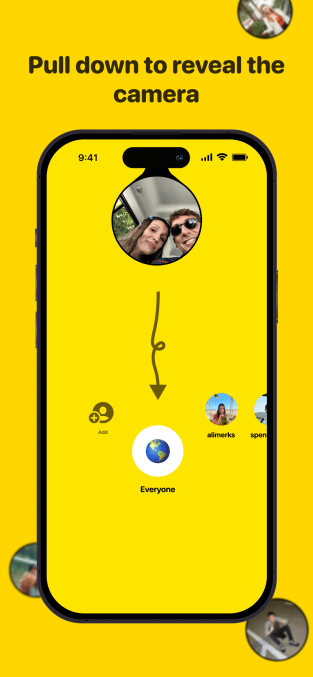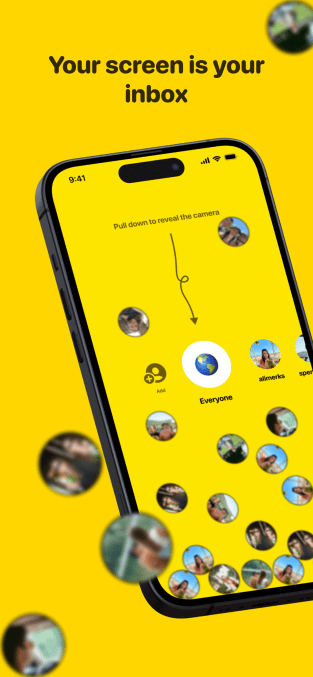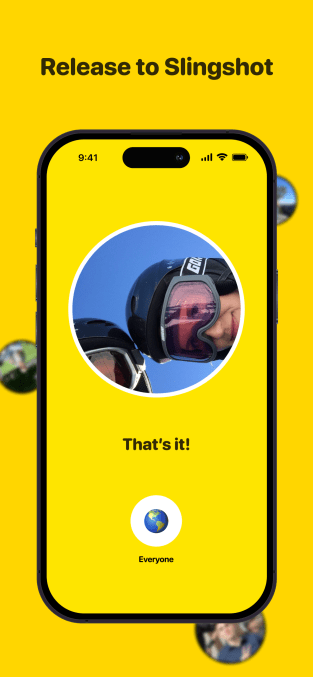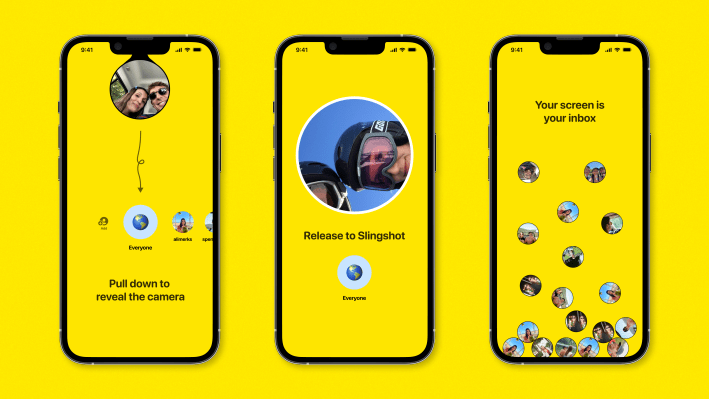A clever new app called Slingshot is combining the serendipity of BeReal snaps with the friends-only photo sharing popularized by apps like Snapchat. But while the app’s inspirations are familiar, the way you interact with Slingshot offers something unique. As the name suggests, you pull down on the screen — as if pulling back on a slingshot itself — to reveal the app’s camera. Then, with a satisfying release and a bit of haptic feedback, your candid photo flies off the screen, headed toward your friends’ app where it arrives as a bouncing bubble.
This sort of interaction feels new and fresh — and gives Slingshot a bit of that dopamine rush that you might experience in other apps when you pull to refresh the feed to see new content populate. Except in this case, your slingshot photo is sent out in the world in the hopes of receiving one in return from your friends.
The new app was designed by Tommy Searle, who, after graduating from the University of Michigan, recruited friends to work on a mindfulness journaling app called Wellnest. The app launched in the App Store in January 2021 and the team shortly thereafter raised a pre-seed round to fuel their efforts. However, after six months of selling Wellnest licenses to different universities, the team decided they wanted to build something more consumer-oriented.
Over the past two and half years, the team rolled out five different consumer apps, including a Reddit client called Sideline and a popular iMessage extension called Cutouts for taking photos and reacting with your face, among others. With Cutouts, Searle notes, they had the opportunity to raise more funds but he declined to do so.

Image Credits: Slingshot
“I didn’t see a world in which an iMessage extension was going to be a big enough business to really validate that investment,” he says. Instead, Searle continued to use the pre-seed funds to build other apps that he hopes to take bigger — “apps that are social and that connect us in new ways or present new mediums to connect on our phones,” he notes.
That now includes Slingshot, a simple and well-built consumer social app that moves you quickly through the onboarding process of validating your phone number and giving the app the necessary permissions to access the camera and your contacts and deliver notifications. (Searle notes the app hashes phone numbers before they leave your device, so it’s only comparing hashes, not actual contact information, to match you with friends.)
After setup is complete, you can add friends and begin to “slingshot” photos to them whenever you please. There’s no push notification reminder as in BeReal that requires you to post at a certain time.

Image Credits: Slingshot
The app’s camera mechanism is so simple, in fact, that it’s almost surprising when you first use it. There’s little time to pose or frame your shot — you just pull back on the screen and release to snap the pic and send it flying.
Searle says he began working on the app just six weeks ago.
“I don’t know where or how the idea of pulling down to reveal the camera came to me,” he says. “I just remember drawing it on my Notepad one day, and I was really interested in this feeling of instantly being able to send something and the idea of releasing to take a picture and send it instantly…It felt like it had some elements of BeReal and Snapchat and also Cutouts, with the circular images.”

Image Credits: Slingshot
The app’s playfulness isn’t something only available to the sender. As the receiver of slingshot photos, little balls — or marbles? — bounce across the screen and then settle in a pile. You can tap on these to reveal the photo and then it disappears. There’s no repeat viewing allowed.
When using Slingshot, you can opt to send your slingshot photo to “everyone” — the default — or you can choose a specific friend or friends from your list to send to instead.
The app launched in the App Store is essentially a beta that Searle now aims to develop further. He’s toying with ideas like being able to sling videos or text. Despite its similarities to other apps, Searle thinks the app will appeal to high schoolers or college students because it’s focused on capturing things in the moment — not just at the time BeReal specifies. And it’s faster than using Snapchat, he points out.
“You’re pulling down and releasing and it’s instantly sending. So it is faster to get something from my phone to someone else’s using Slingshot than it is on Snap,” Searle says.
If the app takes off, Slingshot may monetize with paid upgrades that would allow users to prioritize their best friends in the app by putting them at the front of the carousel, for example.
As Wellnest, the startup raised $750,000 from Progression Fund, a fund featuring many ex-TikTok execs, along with angels like Austin Rief from Morning Brew and Turner Novak.
Now a sole founder — other members have since left Wellnest — Slingshot was built alongside founding engineer Sakun Acharige.
Slingshot is currently a free download on iOS only. An Android version will be built only if the app takes off.
